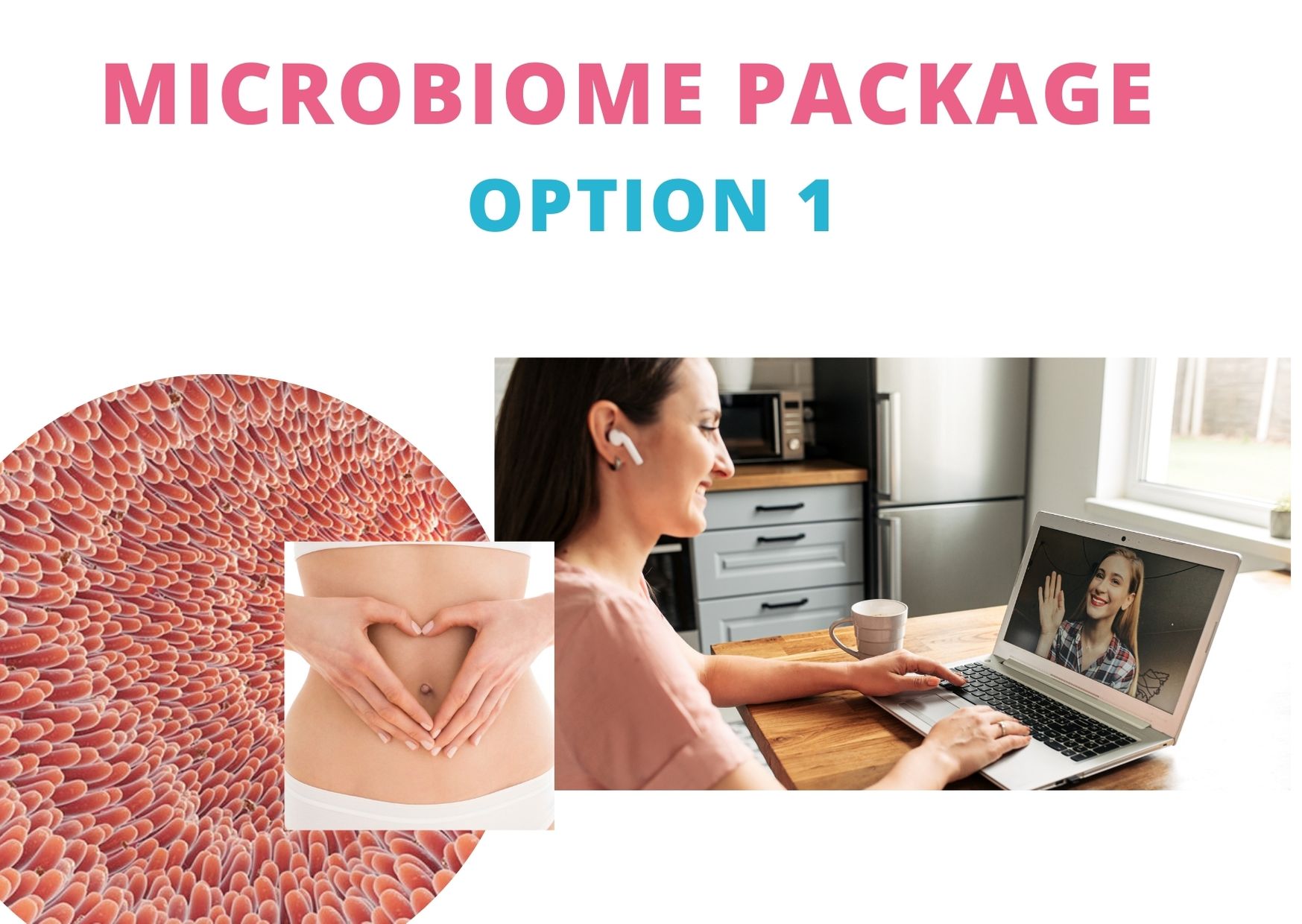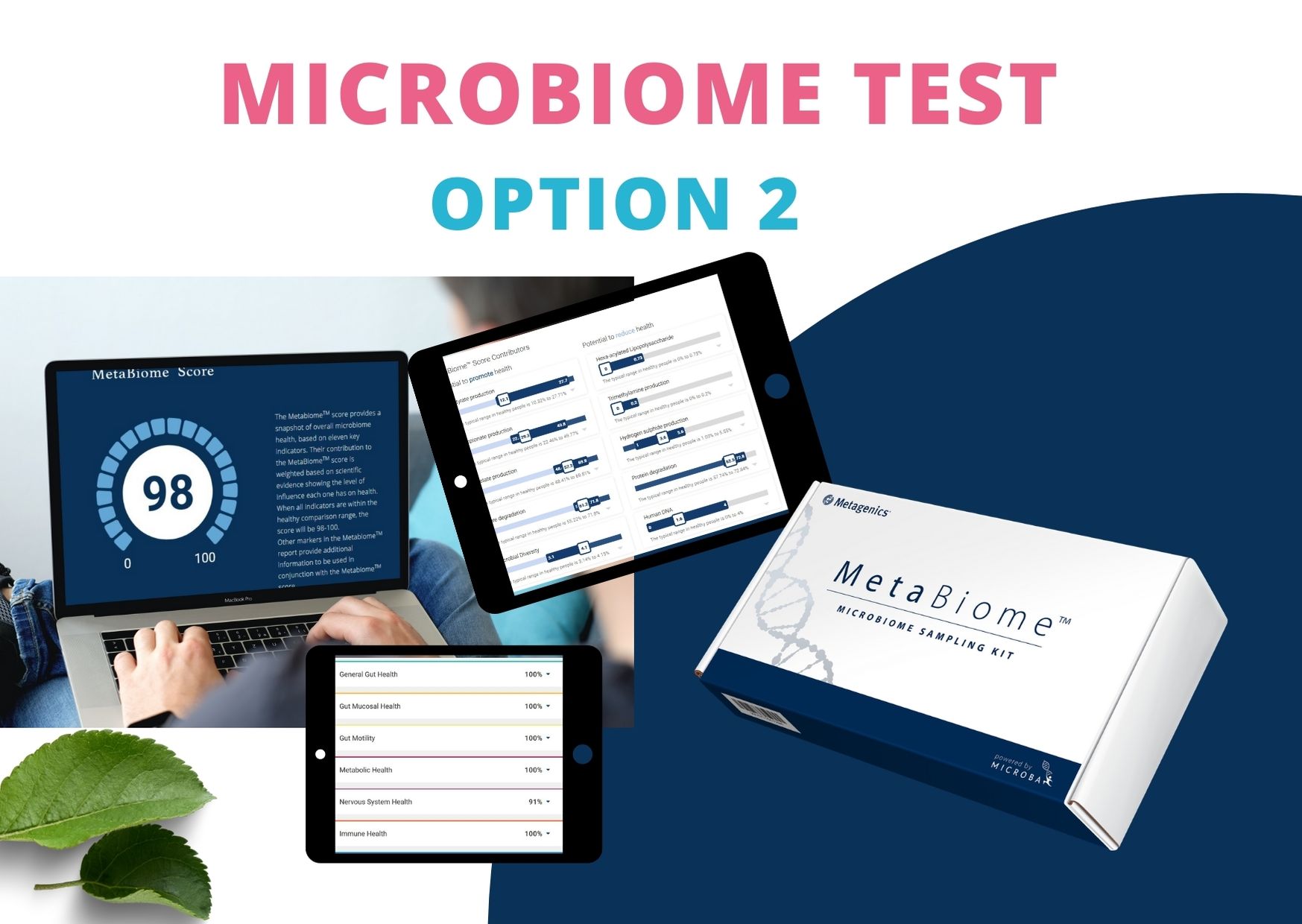The
Microbiome
Screening Test
What is the Microbiome Test?
The Microbiome Test is a comprehensive approach that gives great insight into your microbiome living in your large intestines .
We offer a special all inclusive package option. This gives you a couple of ways in which you can move forward and order your kit and register for the testing as soon as possible Choose your Microbiome testing option.
What does the screening test include?
Comprehensive gut microbiome test.
A full report of finding and interpretation of the microbial communities destectd and overall gut health.
Personalised treatment protocol prescribed.
2 x 60 minute one-on-one Zoom health consultations.
Personalised holistic, dietary and lifestyle recommendations for clinical application based on report findings and your own health history.
$675.00
Complete consultation package with microbiome testing
Option 2
This includes the test kit, the test and full report emailed to you directly. Priced at $500.00 ( not including a consultation) but once the the report is completed you are welcome to book a consultation at your convenience.
Now that I have made my purchase, what happens next ?
The package includes the test kit which is sent directly to your address.
The findings are emailed to me in a full report and I forward this to you.
The report is very scientific. So I really need to unpack it for you and give a full interpretation. If you want me to do that I then spend at least 40-60 min reviewing & researching the findings. Following that I arrange at least 1 60 minute session with you to go through the findings.
Here we delve into your symptoms and the report findings and recommendations based on your case history and the report findings. 90 minutes is allocated here which includes 30 minutes for me to research the reports findings That’s normally priced at ( $195.00).
If your a new client I like to have an initial session before the test.
So the microbiome package includes an extra 90 minutes which includes 60 minute consultation and 30 minutes research. But you need to purchase it as a package up front at $675.00 to get the full bonuses .
What the Heck is living in my gut?
Want to know how your gut microbiome is doing? A fantastic tool is available to investigate the composition of your own personal microbiota. This involves sending a stool sample for laboratory analysis. The Microba Lab use a method termed ‘metagenomics’ to sequence all of the DNA in your sample, allowing them to detect which microbial species are present, their relative abundance and their potential function in your gut. A report is then generated that gives insight into your gut health and how this could be impacting your overall wellness.
MetaBiome – SUMMARY OF TEST:
Microba analyses your gut microbiome using a full metagenomic method of comprehensive DNA sequencing. This powerful tool identifies all of the microorganisms in your sample – bacteria, fungi, parasites, archaea – unveiling the overall microbial composition of your gut. The ability of metagenomics to reveal specific (species-level) identification of these microbes allows for functional information to be obtained: what they are doing and how this may contribute to your health
THE MICROBIOME
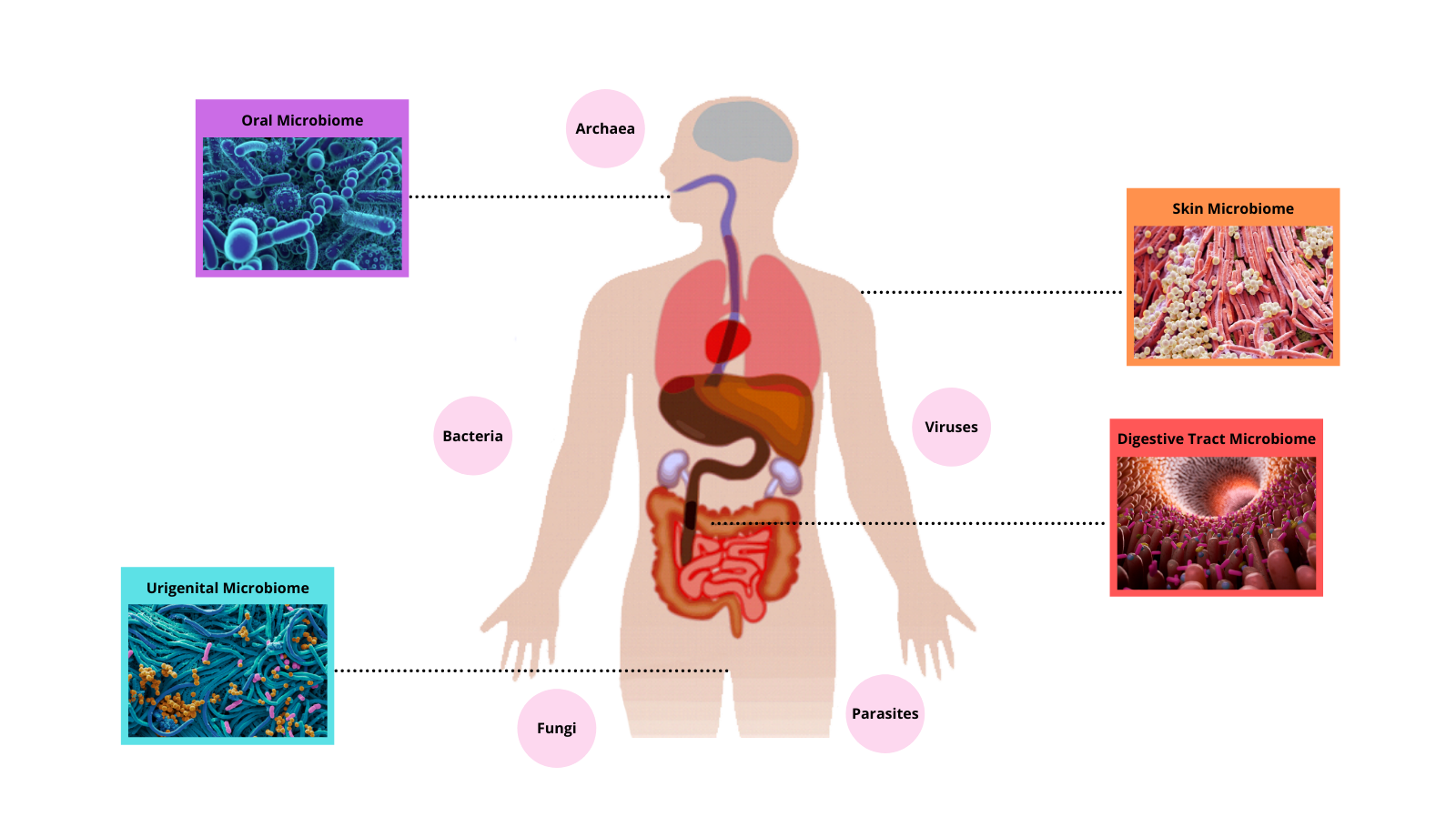
Microorganisms are everywhere – in, on and around us! Amazingly, the number of microbes that live in the human body are more plentiful than the number of our own body cells! Different regions of our body are colonised by different communities of microbes, most of which are harmless or beneficial to us – as long as we provide them with a healthy environment to live in. The community of microbes that live in our lower gastrointestinal tract, collectively termed the ‘gut microbiome’, play a vital role in maintaining our overall health. It is comprised of bacteria, fungi, protists and viruses. Food that is not absorbed in the small intestine passes through to the colon (large intestine) where the gut microbes feast on it, producing metabolites that are then absorbed into our bodies.
Our gut microbiome, while predominantly similar to others around us, is in fact unique to our own body and is ever changing depending on what it is exposed to. Diet, genetics, medications, exercise, stress and aging all influence the make up of our gut – for better or for worse! A healthy microbiome plays a vital role in nutrient and mineral absorption, provides us with essential enzymes, vitamins and amino acids, helps regulate mood and shapes our immune system. An unhealthy microbiome – termed ‘dysbiosis’ – has been demonstrated to drive inflammatory disease, autoimmune disease, weight issues, mental health issues, cancers, metabolic disease and neurodegenetive disease. So, it’s important we consider the health of our gut as a major part of our wellness journey.
How can we maintain a healthy microbiome? We aim to support beneficial microbes and their metabolites, while reducing those that are detrimental – begin with feeding ourselves well! The foods that we eat drive changes in the microbial species that live in our gut, for example – a high sugar diet leads to overgrowth of sugar-loving microbes that can produce metabolites that are harmful to our body, while those that live on fibre are more beneficial. A wide and varied diet that is full of goodness results in a rich and diverse microbiome in the gut, ultimately leading to better health for our whole body! Supplementation with good quality pre- and pro-biotics can boost beneficial bacterial species, and aiming for an active lifestyle where stress is minimized also has significant impact on our gut health.
Our in-depth module ‘Gut Health and the Microbiome’ provides a wealth of information on how you can shape your diet and lifestyle to promote a healthy gut, including specifics on which foods significantly impact health or disease, and the latest science on lifestyle and environmental factors that influence our gut microbiome. Combined with the analytic report of your microbiome testing, these valuable insights can be pivotal to help you better understand what your body needs to move forward in your health journey.
What Food Makes it to the Gut Microbiome?
The small intestine absorbs most of the nutrients from the food we eat
Food that is not absorbed by the small intestine passes to the colon where it is available for our gut microorganisms
This is mainly fibre, excess protein and fat
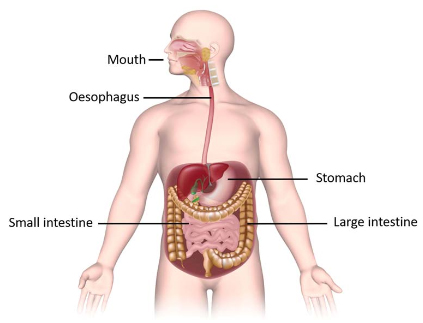
Structure of the Colon
The largest population of bacteria live in our large intestine1, also known as the colon. The structure of the large intestine consists of densely-packed folds of tissue, called “crypts.” The surface of the large intestine, including the crypts, are lined with epithelial cells.

Above the epithelial cell layer are two layers of mucus: a dense inner mucus layer and a loose outer mucus layer.
These mucus layers are produced by cells within the epithelial layer, and primarily consist of a protein called mucin which has sugar side-chains attached to it called glycans2.
Beyond the two mucus layers is the space where the undigested food is pushed through, called the lumen.
Factors Influencing the Gut Microbiome
Diet is the most influential factor affecting the gut microbiome, followed by medications.
Other factors such as stress, exercise, ageing and host genetics can also influence the gut microbiome1.
Best time to collect a sample is when person maintains normal diet and lifestyle habits for ~1 week
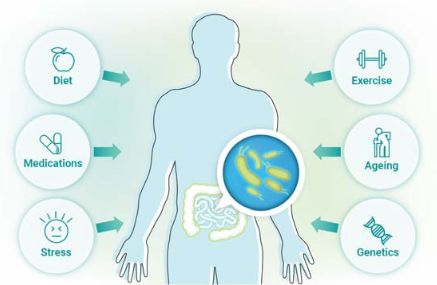
Frequently Asked Questions
What is meant by richness, evenness and diversity?
Richness refers to the total number of different bacterial species present in an individual’s gut microbiome; the higher the number of different species, the ‘richer’ the sample. However, richness does not take into account the amount of each different species present in the sample.
Evenness refers to the relative abundance (amount) of each species in an individual’s gut microbiome, i.e. how numerically equal the bacterial community is. High evenness suggests that the species are present in relatively equal amounts, whereas low evenness indicates that a few species predominate.
Diversity is the measure of both the number of different types and the amount of bacterial species in the sample, i.e. it encompasses both richness and evenness. A highly diverse sample would contain a large number of different bacterial species (high richness), with a relatively equal amount of each species (high evenness). While low microbial diversity is often associated with poor health, high microbial diversity is associated with good health. A varied diet rich in plant-based, fibre-containing foods, such as fruits, vegetables, wholegrains and nuts, is associated with increased microbial diversity.
What is the Shannon index?
The Shannon index is a standardised measure used by members of the scientific community to quantify species diversity in an environment (such as an individual’s gut microbiome). Comparing Shannon index values over time can identify changes in diversity.
How does shotgun metagenomics compare to other methods such as PCR/16S rRNA?
Polymerase chain reaction (PCR) testing methods extract the DNA from the faecal sample and probe it to identify the tag of a specific bacteria or pathogen. This probing is only carried out for specific microorganisms within the sample and as such cannot provide a complete compositional analysis. Therefore, the spectrum of organisms that can be detected via this method is limited to only a small number of species. However, the method provides high detection sensitivity of specific organisms and if quantitative PCR is used, can also provide a measure of the abundance of detected organisms.
16S rRNA – 16s ribosomal ribonucleic acid (rRNA) sequences a small portion of a single gene found on bacteria. This acts as a fingerprint to identify known bacterial groups but is very similar amongst species, so can only identify down to the genus level. Considering there may be 100 species within any genera, there is no way to determine the health impact of that genus nor its functional metabolites. Likewise, as the method is screening for identified tags of known bacteria, it is unable to detect unclassified bacteria, or other organisms that can be present in the microbiome such as fungi, protists and viruses. It is also important to consider that different labs will use different regions of the gene portion and as such the method is not reproducible across labs.
The MetaBiome™ test uses the latest technology available (shotgun metagenomics) and provides the broadest and most detailed picture of all microorganisms within the microbiome. From a faecal sample, metagenomic sequencing takes in all the genetic material of the gut microbiome. It accurately identifies microorganisms down to the species level; rather than the genus level as many tests currently do, and it looks promising to facilitate strain level detection within the next year. This screening technology is not just limited to detecting known bacteria, but is able to sequence undefined bacteria that will provide valuable insights as more is learnt about them. Likewise, it can accurately sequence genes for all microorganisms and detect levels of viruses, ungi, archaea, protists and parasites, which are just as influential as their bacterial counterparts. This methodology extends beyond compositional analysis to also include functional capacity of the microorganisms present and records their produced metabolites. This provides an understanding of the functional health of the microbiome and its potential to influence the patient’s physiology. As such, metagenomic sequencing is the most reproducible, accurate and comprehensive DNA sequencing method of the microbiome that not only provides an assessment of ‘who is there, but also what they are doing’.
What parasites can the MetaBiome™ test detect?
The MetaBiome™ test detects protists and parasites for which there is genomic information available on the Genome Taxonomy Database. For example, Blastocystis can be detected, while Dientamoeba cannot, as there is currently no available genomic information on this parasite. For species where genomic information is available, the test can detect them in abundance over 0.05%.
It is also important to note that parasites are not evenly distributed throughout the stool. As the MetaBiome™ test only uses a tiny amount of faecal material, a parasite will not be detected if it is not present in the stool sample, even if it is present in the individual’s gut. Additionally, the report is not medically diagnostic and is intended for informational purposes only. If a parasitic infection is suspected, consult with a medical practitioner and select a test that collects the whole stool for analysis (e.g. PCR).
Should my patient stop taking probiotics or antibiotics before the MetaBiome™ test? If so, for how long?
There is no need to stop taking probiotics or other supplements before the test, as these are part of the patient’s regular habits and will reflect their “normal” microbiome. In general, maintaining the patient’s regular supplements for two weeks prior to sampling is recommended. Additionally, it is advised to collect a sample from a bowel movement that is typical for that patient in order to capture a “normal” microbiome sample.
Antibiotic use however, is one exception to the rule, as it does affect the microbiome. It is advised that testing should be conducted at least 2 weeks after antibiotic use, once any acute symptoms have resolved.
How is the MetaBiome™ score calculated and what does the score indicate?
The score is an indication of the patient’s overall microbiome health, based on the eleven categories listed in the MetaBiome™ report. The contribution of each category to the MetaBiome™ score is weighted according to the level of influence it has on a patient’s health. The current healthy comparison range for the MetaBiome™ score is 98% to 100%.
My client has a MetaBiome™ score of 98 but has multiple chronic digestive symptoms. Why is this?
The score is a specific reflection of microbiome health, and is not indicative of overall gut function. It therefore does not reflect other causes of digestive complaints, such as alterations in motility, absorption of nutrients, and elimination of waste. If the patient has a high MetaBiome™ score but presents with chronic digestive symptoms, this is an indication of a functional cause, rather than an imbalanced microbiome.
Why are there species in the MetaBiome™ report with code names or numbers but no information about them?
Currently the laboratory does not have any information available about these species. This is either because they are new species that are yet to be classified by scientists, or they are uncommon species of the human gut, whose exact function is unknown. The MetaBiome™ report will continue to evolve as new information about these species is discovered.
Does low human DNA exclude leaky gut?
A high amount (greater than 4%) of human DNA on the MetaBiome™ report suggests increased epithelial cell turnover, indicative of gut inflammation at the time of sampling. However, having low human DNA does not completely exclude leaky gut, as intestinal hyperpermeability can still be present due to reduced tight junction integrity, without overt inflammation.
Can you explain the different types of lipopolysaccharide (LPS)? What is Hexa LPS?
LPS is an important protective component of the cell wall of many gram-negative bacteria. However, when these bacteria die, their cell walls break down, releasing LPS into the gut where it can have a pro-inflammatory effect.1 Diets high in fat, especially saturated fat, allow LPS to cross the intestinal barrier and enter the bloodstream. This is because lipophilic LPS can incorporate itself into the chylomicrons (small fat globule) that transport dietary fat into the bloodstream.2
LPS comes in two forms – hexa and non-hexa LPS, classified according to molecular weight. Hexa LPS contains six acetyl chains or more (higher molecular weight), while non-hexa LPS contains less than six (lower molecular weight). Hexa LPS is pro-inflammatory and has been associated with diets high in fat, particularly saturated fat.3 It has also been observed in individuals with cardiometabolic conditions, such as heart disease, type 2 diabetes, non-alcoholic fatty liver disease, and obesity.4 Non- hexa LPS has not been associated with any negative health outcomes and may actually exert beneficial effect through immune modulation.
Is high short-chain fatty acid (SCFA) production a problem? I thought they were beneficial?
While SCFA production is generally a positive factor, high amounts can indicate an increased abundance of microbial species that are associated with negative health outcomes. For example, Bacteroides fragilis primarily produces succinate and the SCFA, acetate. Although the non-toxic strains of B. fragilis may have beneficial effects, the toxic strains have been correlated with diarrhoeal disease, inflammatory bowel disease flare-ups, and colon disease.6 Thus, increased production of SCFAs may indicate the presence of dysbiotic organisms. Levels of SCFA are therefore optimal when they fall within the appropriate reference range.
Why would someone be high in both protein and fibre degradation?
This indicates that the patient has microbial species with the capacity to use both fibre and protein as fuel sources. Levels are mostly dependent on the patient’s diet.
Branched chain amino acids (BCAAs) benefit muscle growth and general health. Why are they considered ‘bad’ in this report?
BCAAs are building blocks for muscles, and are involved in the regulation of glucose and fat metabolism, as well as the immune system. Despite their health benefits, high blood levels of BCAAs have been associated with obesity, insulin resistance and other metabolic diseases.7 In addition to dietary sources, BCAAs can also be derived from the gut microbiome. Research indicates that an increased microbial gene abundance for BCAA production, is correlated with increased blood levels and may be associated with the aforementioned conditions.
What is the significance of gamma-butyric acid (GABA) production or consumption in the microbiome?
GABA is an important signaling molecule for the brain, with low levels associated with anxiety and depression.9 It is primarily produced by the body, however some bacterial species can also produce (and consume) GABA. Excess GABA may be transmitted from the gut to the brain via the vagus nerve, however the role of bacterially produced GABA is still unknown, and its effects on anxiety and depression is an active area of research.
What is the significance of trimethylamine?
Trimethylamine is a compound produced by some gut microbes that is converted to trimethylamine-n-oxide (TMAO) in the liver. Increased TMAO levels have been observed in individuals with heart disease, type 2 diabetes, cancer and vascular dementia.10 However, the role of TMAO in these diseases is still unclear, and it is unknown if TMAO is a cause or a marker of these diseases, or if it plays a protective role in repairing damage caused by these diseases.
TMAO levels are influenced by many factors, including the gut microbiome, diet, the integrity of the gut barrier, liver function and kidney function.11 Although diet may play only a small role, diets high in red meat, eggs and salt, have been associated with increased TMAO levels, while diets high in soluble fibre have been shown to reduce trimethylamine and TMAO levels. If your patient’s potential to produce trimethylamine is high, increased consumption of fibre and avoidance of excessive amounts of red meat, eggs and salt is recommended. Additionally, although several gut microbes can produce trimethylamine, some can also use it for energy, thus reducing its levels. Therefore, it is considered beneficial if a patient’s gut microbiome has the potential to consume trimethylamine.
What is the significance of 3-indolepropionic acid (IPA)?
IPA is a potent antioxidant produced by some gut bacteria from the breakdown of the amino acid, tryptophan. Research suggests that IPA is a scavenger of hydroxyl radicals and protects against oxidative damage in different tissues, including the nervous system.12 Animal models also suggest that IPA may play a role in maintaining gut barrier integrity by acting as a ligand for the xenobiotic sensor, pregnane X receptor (PXR).13 Further, low levels of IPA may play a role in the development of type 2 diabetes14 and plasma levels of IPA have also been found to be significantly lower in subjects with Huntington’s disease compared to healthy controls.15 Studies indicate that consuming foods high in dietary fibre (rye-containing foods in particular), can increase IPA production.
How do we prioritise treatment?
Antimicrobial treatment may be considered if the MetaBiome™ report indicates a significant abundance of detrimental species, or if parasitic detection has been reported. In most other cases, optimising the microbiome through the inclusion of pre- and probiotics should be considered the first line treatment.
What is the significance of high hydrogen sulphide production?
Hydrogen sulphide gas is a byproduct of the breakdown of sulphur-containing foods, such as eggs, garlic, onion, cabbage, kale or Brussels sprouts, by certain species of the gut microbiome. It can also be produced by bacterial metabolism of bile acids.1 Hydrogen sulphide plays an important role in gut health as an energy source for intestinal epithelial cells, with a protective effect on gut barrier function. However, some studies have suggested that high levels of hydrogen sulphide can also disrupt the mucus barrier of the gut and predispose susceptible individuals to certain health conditions such as inflammatory bowel disease.
How long should I wait before retesting?
Retesting can be conducted after three to six months, depending on the individual case. Many individuals will retest on an annual basis to ensure their microbiome composition remains optimal.



